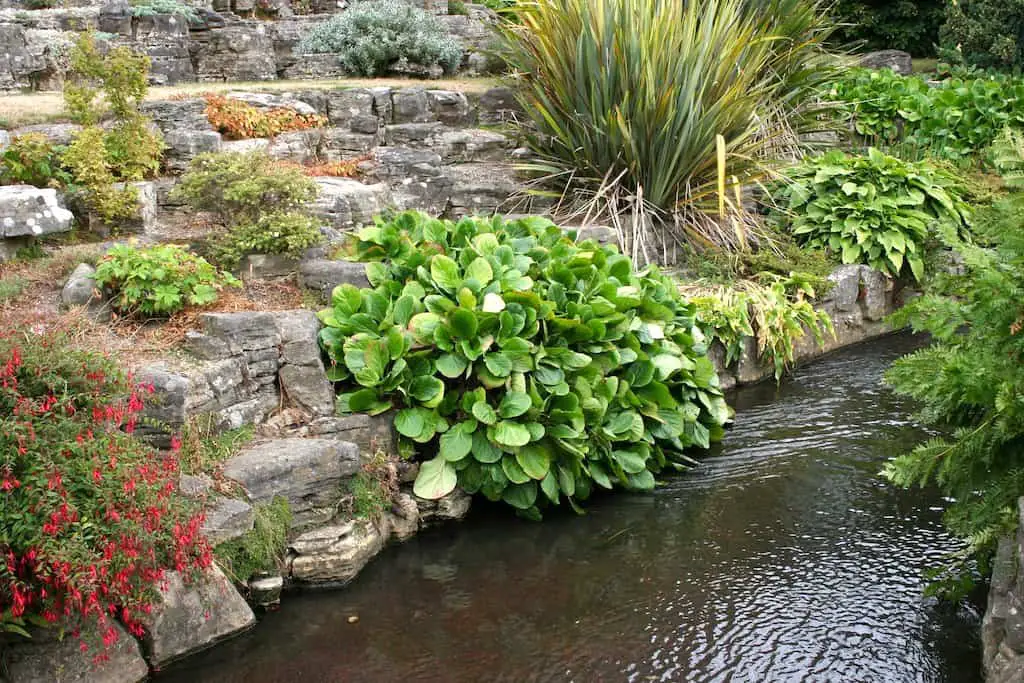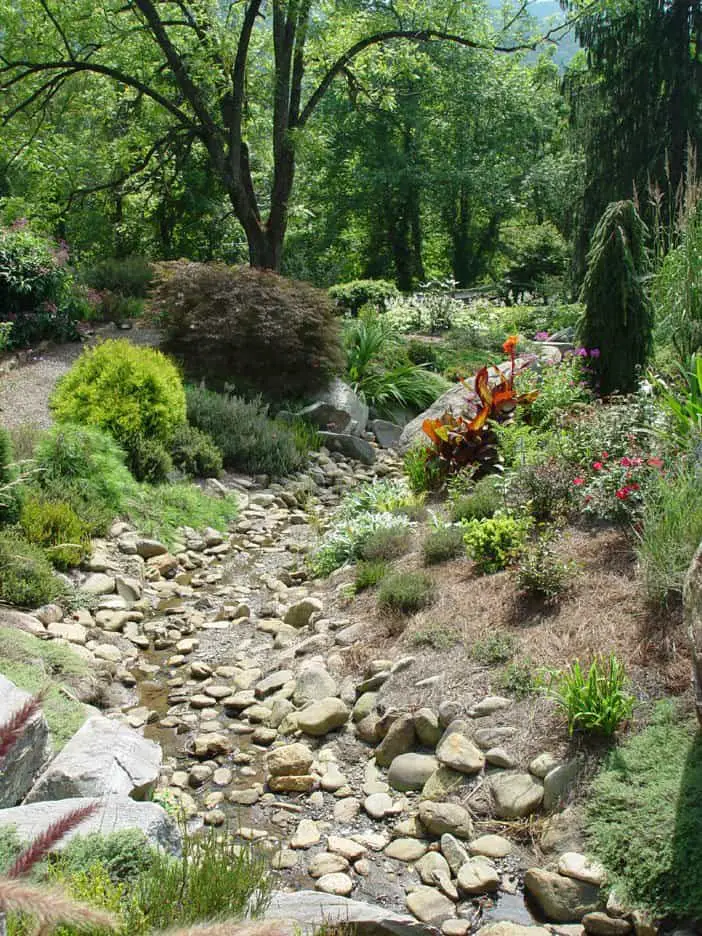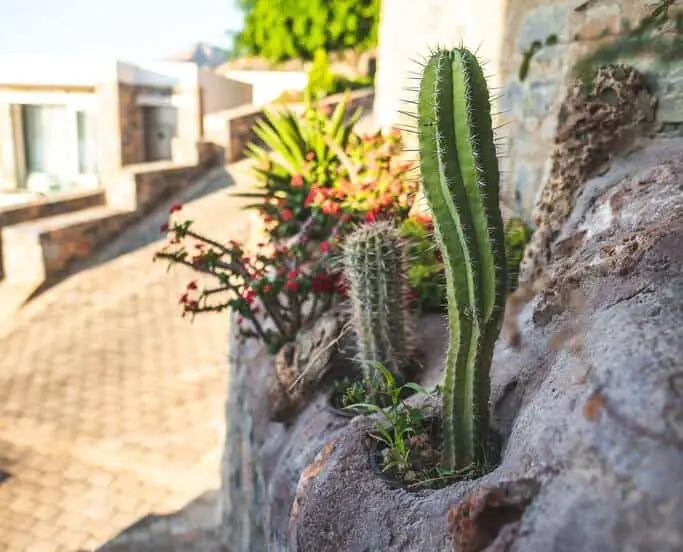Is your garden dry and dull? Then create a rock garden! I will show you how you can transform rocky garden areas, bare garden plots, rock walls or fence rows into a colorful flower paradise full of life.
Rock gardens can be very diverse. They offer an attractive and simple way to transform a challenging garden situation into a blooming landscape.
Do you have an aging, old rock wall? Great! An aging rock wall can be the perfect place to start a vertical rock wall garden. There are always good places for rock garden plants to grow in the cracks between the stones.
Rough and rocky hillside plots that would be very difficult to turn into a perennial flower bed might be the perfect spot to create a rock garden. Adding stones and plants to an already rocky hillside to create your rock garden will not only look attractive but will help to prevent erosion as well.
A rock garden is also an excellent alternative to border and delineate your property or lawn edge with a very natural look. There are often stone walls and rocky fence rows that border properties in the countryside, and many can be planted with various rock garden plants to create a beautiful, low-maintenance rock garden and privacy screen.
Table of Contents
Styles of Rock Gardens
There are many ways to create a rock garden and many different styles to chose from. The type of rock garden that you make will likely depend greatly on what part of the country you live in and what supplies you have at hand.
Most of the rock gardens that I have seen fall into two categories; the vertical rock garden and the horizontal rock garden.
Vertical
As mentioned earlier, an existing rock wall can be a great place to create a rock garden. When talking about rock walls, I feel that it is best to clarify a bit. There are several rock wall styles, and they might not all be as well suited for rock gardens as you might think.
The most common types that I have seen turned into rock gardens are the low, boulder style retaining walls that might hold back grades and terrace a sloped yard. These walls are typically dry laid, meaning no mortar is applied between the rocks. This type of wall is often perfect for rock gardens because it is usually built right against the dirt and often has lawn or a flower bed in front or behind it.

To create a rock garden in this type of wall is perhaps the easiest of them all. The wall already exists, and there is already dirt in the holes between the rocks. You simply need to find plants that will grow in the wall and then plant them in all of the nooks and crannies between the rocks.
The other type of rock wall that I have seen used for rock gardens is the free-standing, dry-laid rock wall. This type of wall will typically not have dirt between the rocks but will instead be comprised of carefully stacked rocks that rely on gravity to keep them in place. Walls such as this have been used to border yards and farm fields for many years and are more prevalent in Europe than in the United States. This type of wall takes a great deal of patience and skill to build, so I am reluctant to encourage you to fill the blank holes with soil and plants. Over time, if the wrong plants are chosen, the roots could move the rocks and cause the wall to fail. Another concern with a wall like this is weather-dependent. Dry laid rock walls are intended to remain dry. If a wall such as this is backfilled with soil, it will hold moisture. If this wall happens to be in a part of the world that experiences freezing temperatures, this moist soil will freeze and expand, which will likely cause the wall stone to move over time.
Another type of vertical wall is the free-standing masonry or wet set wall. Walls like this are built similarly to the dry-laid vertical walls, but these walls are typically set on a footing or foundation, and the stones are held together using mortar. Walls such as this are the most expensive walls to build and would once again be prone to damage from roots and freezing soil in the cracks. My advice would be to avoid planting into a wet-laid masonry wall.
Horizontal
The other style of rock garden that I have seen, and probably the most common, is the type that is typically just laid on the ground. Sometimes these start as rocky hillsides, and sometimes they start as old fence rows of rock. Either way, there is no fear of ruining an existing structure since the rock is already on the ground or maybe stacked a couple of stones thick in the case of a fence row. These types of areas are perfect. If there are already many rocks but little soil, you will want to add some soil between the stones. If there are few rocks and mostly soil, you will want to add rocks to create more interest.

Further Considerations
Depending on where you are located, you may want to consider a few things before deciding on the rock garden style that you will create. If you are in a very arid and dry region, it may be difficult to get plants to grow in a free-standing wall because they will dry out quickly. If you wanted to create a vertical, free-standing rock garden in a climate like this, I would suggest only the most drought tolerant plants that you can find. You might want a horizontal rock garden right down on the ground in this sort of environment. The rocks will help collect moisture and protect the soil from the hot sun, and the plants will have the opportunity to grow into the native soils, which will make them more drought tolerant.
On the other hand, if you live in a very moist and humid area, the horizontal garden might be too wet for most rock garden plants, in which case you would be better off creating a vertical rock garden where the plants can dry out a bit more. You need to understand your environment.
Plant Choices
Once you’ve decided on the type of rock garden you will create, you can consider the plants you might want in your rock garden. Some of the most popular rock garden type of plants that I have seen used are the low growing, creeping, crawling variety of plants such as:
- Creeping Thyme
- Wooly Thyme
- Hens and Chicks
- Snow in Summer
- Alyssum
- Sea Thrift
- Ice Plant
- Creeping Sedum
- Soapwort
- Creeping Juniper
- Creeping Phlox
- Creeping Cotoneaster
- Rock Cress
- Candytuft
- Bellflower

Alternatives
Many people like to plant their rock gardens tight with perennial plants. I find that sometimes it’s a nice idea to leave some blank spaces for annual flowers. Planting low-growing annual flowers into your rock garden will give you the opportunity to very easily change the look and feel of your garden every spring. And who doesn’t look forward to that first trip to the greenhouse to pick out some new annual flowers?
Location
When you are planning out your rock garden, consider its location. Is it in the center of your yard where you can view it from all sides? Is it at the side of your yard where you can only view it from one side? If it is one-sided, then it is often nice to plant some attractive taller plants behind it as a backdrop. This will allow you to have a tall perennial or shrub border in the back with a low rock garden in front. If you will be viewing it from all sides, keep the taller plants near the center and the lower plants near the edges. This will give you great views from all sides.

Rock type
You must also consider the type of rocks that you will be using. You can go all out and purchase any rocks that you would like. There are many types of beautiful rocks to choose from, but I most often see folks using the rocks that they or a neighbor might have on-site. Either way, choose your plants in relation to the rocks that you will use. The larger your rocks are, the larger your plants should be, and vice versa. If you have small stones and plant larger plants, the plants will overwhelm the rocks, and it will look more like a mounded perennial garden than a rock garden. If done correctly, the garden should showcase the plants and rocks equally. Often it is necessary to trim back the plants during the growing season to be sure that you keep some rock exposed.
If you are planting into an exiting vertical wall, I’d suggest using only soft rooted, easily controlled creeping perennials. These plants will beautify the wall, be easier to maintain, and will not be as likely to damage the wall should they need to be removed in the future.
Rocking On
In general, rock garden plants like it a bit dry and rugged. Any plant that will grow in your climate and that likes to be dry and stays relatively short compared to your rocks will be a great addition to your rock garden. Don’t forget that your rock garden project will likely be a work in progress. You may plant some plants that grow too quickly that you will need to remove; you may plant other plants that don’t survive for one reason or another. As with any flower beds, it’s not about getting it perfect and proper the first time; it’s about what it grows into over time. Too many landscapers and gardeners over plant when installing their landscapes which only results in the necessity to remove plants as the years go by or some of the plants will simply get snuffed out by their more aggressive neighbors. It is better to start a bit sparse and let the plants grow in. Different plants will grow differently in different locations. You need to plant, care for and observe. Your gardens will tell you what they need over time.

